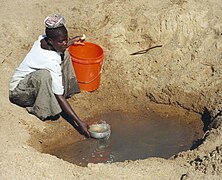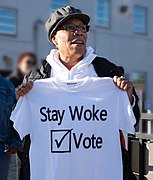I began my water journey on April 11, 2023. I decided to completely cut out all beverages besides water cold turkey. This may not have been the best thing for me to do considering I learn very quickly that I had a caffeine dependency. In result for the first week I was having caffeine withdrawals which resulted in migraine headaches and extreme fatigue. I chose to do it this way, even though it caused myself a lot of physical discomfort, because the women and girls that suffer from water insecurity and lack of clean water do have the luxury of weaning themselves off of water. One week they may have access to water and the next they may not. 
(This is a map of countries where the CDC has deemed it safe to drink tap water https://www.globehunters.ca/blog/safe-tap-water.htm.)
Water insecurity also results in physical discomfort and dehydration, so I thought to myself “if I am trying to raise awareness and change my mindset on how we take water for granted I should also experience discomfort with completely quitting coffee, sodas, juices, and even water flavoring packets”. During this semester we studied the human rights issues associated with water insecurity and lack of hygienic resources. The United Nations Water and  Gender article states that “women and girls are more vulnerable to abuse, attack and ill-health, affecting their ability to study, work and live in dignity.” https://www.unwater.org/water-facts/water-and-gender. As I was going through the physical discomforts of switching to water only was when I really began to ponder on the physical discomforts that women and girls would experience rather than just the physical dangers as they relate to violence. While I believe that the risk of violence upon women and girls should be at the forefront of conversation, we can not forget that they are also personal, physical discomforts associated with water insecurity According to the Cleveland Clinic water insecurity will result in: Physical Symptoms of: headache, delirium, confusion, tiredness (fatigue), dizziness, weakness, light-headedness, dry mouth and/or a dry cough, high heart rate but low blood pressure, loss of appetite but maybe craving sugar. flushed (red) skin, swollen feet, muscle cramps, heat intolerance, or chills, and constipation. And Mental Issues of: Confusion, crankiness, and anxiousness. With these symptoms also playing a role in the risks of violence and physical illness. https://my.clevelandclinic.org/health/treatments/9013-dehydration
Gender article states that “women and girls are more vulnerable to abuse, attack and ill-health, affecting their ability to study, work and live in dignity.” https://www.unwater.org/water-facts/water-and-gender. As I was going through the physical discomforts of switching to water only was when I really began to ponder on the physical discomforts that women and girls would experience rather than just the physical dangers as they relate to violence. While I believe that the risk of violence upon women and girls should be at the forefront of conversation, we can not forget that they are also personal, physical discomforts associated with water insecurity According to the Cleveland Clinic water insecurity will result in: Physical Symptoms of: headache, delirium, confusion, tiredness (fatigue), dizziness, weakness, light-headedness, dry mouth and/or a dry cough, high heart rate but low blood pressure, loss of appetite but maybe craving sugar. flushed (red) skin, swollen feet, muscle cramps, heat intolerance, or chills, and constipation. And Mental Issues of: Confusion, crankiness, and anxiousness. With these symptoms also playing a role in the risks of violence and physical illness. https://my.clevelandclinic.org/health/treatments/9013-dehydration
Drinking only water also opened up many conversations which I think is key to activism and essential to bringing people awareness of your cause and the change in which you are trying to enact. This opened up many conversations within my workplace because my employees very rarely see me without coffee or an energy drink and when I only had water I was able to tell them about this assignment and why I was doing it. I hope that from those conversations I was able to instill in them that we gave to be conscious of the way that we take advantage of an unrestricted, clean water supply and that they are millions of women and girls that experience water insecurity that lead to infringements on their human rights.

The second part of my Praxis was the hardest for me. I chose to replace my ankle weights with carrying 2 full gallons of water as I walked my dog each day. This was also the part that I was least successful at because my goal was to do this everyday and I did not do that. I walked 3-4 times each week carrying the gallon containers. Also, this was the most eye opening, because personally I am not as physically fit as I should be and carrying water gallons for a mile after a while gets really heavy. I began to experience upper arms and shoulder pain as I would try to carry the jugs different ways to alleviate the discomfort I felt as I was walking. During this time of my assignment I was able to reflect on the privilege that I am afforded because I do not have to fetch and collect and carry my own water home. From this reflection I remembered the image that  was shared in the second week of class when we discussed women and water
was shared in the second week of class when we discussed women and water
and how these containers are much bigger than the gallons that I was complaining about and realizing that the water within them may not even be as clean as the water within my “prop” for this Praxis. (I call the gallon jugs props because this is water that I give to my dogs and cats, and again how privileged we are to be able to purchase spring water for our pets)
Overall, I believe that my Praxis assignment was successful. I admit that I hiccups one too many times. I did not walk everyday, and while I was successful at eliminating sodas and juices I was not completely able to eliminate coffee and water enhancers through this project. But I deem it successful because I became more self aware through my failures. When I would drink a cup of coffee or pour a Propel powder into my water bottle I thought about the water crisis and reflected on my privilege and that water is essential to life and that everyone has the RIGHT to clean and safe water no matter what. Through this project I became more mindful. Another way I believe that my assignment was successful is because I was able to have conversations with the people that are around me the most but may not necessarily know me on an in-depth personal level such as my coworkers. The reason I point out the conversations with people who do not know me super personally is because activism is not only about having conversations with those you are close to or the ones that will not judge. Activism is about being able to have hard conversations in vulnerable situations.
Because as activists it is our job to bring awareness to the social injustices in this world in regards to both our fellow women and girls and the environment. Afterall, Hobgood-Oster stated: “Ecofeminism asserts that all forms of oppression are connected and that structures of oppression must be addressed in their totality” (Hopgood-Oster, page 1). According to Hopgood-Oster, we must address the water crisis in its totality to be able to address the effects of the water crisis on women and girls in totality.
Below I am sharing some images of a walk that I took with my children during the Praxis assignment:




 Throughout this semester we have learned of many different ways environmental degradation and lack of resources has effected women and their advancement in society. For the Praxis Assignment I am choosing to focus on the water crisis that makes being a women in the Global South very difficult. The water crisis does stop at not having access to a clean water supply, but because of the lack of water supply women are oftentimes put in physical danger. Women and girls have the role of fetching water and this can put them in danger by leaving them vulnerable to physical attack, women and girls also have sex specific sanitation needs, and not paying attention to the water crisis is also an equality issue.
Throughout this semester we have learned of many different ways environmental degradation and lack of resources has effected women and their advancement in society. For the Praxis Assignment I am choosing to focus on the water crisis that makes being a women in the Global South very difficult. The water crisis does stop at not having access to a clean water supply, but because of the lack of water supply women are oftentimes put in physical danger. Women and girls have the role of fetching water and this can put them in danger by leaving them vulnerable to physical attack, women and girls also have sex specific sanitation needs, and not paying attention to the water crisis is also an equality issue. With the job of water collection falling mostly on women and girls, and these journeys are oftentimes made on foot, their physical safety is put at risk during these long journeys. But it does not stop there. Many women and girls’ education opportunities are impacted negatively, because of their requirement to collect water they are excluded from earning an income and obtaining an education. Public toilets and restrooms also put women and girls at risk for physical and sexual assault.
With the job of water collection falling mostly on women and girls, and these journeys are oftentimes made on foot, their physical safety is put at risk during these long journeys. But it does not stop there. Many women and girls’ education opportunities are impacted negatively, because of their requirement to collect water they are excluded from earning an income and obtaining an education. Public toilets and restrooms also put women and girls at risk for physical and sexual assault. “Lack of safely managed water and sanitation is an equality issue. Women and girls are disproportionately affected by poor water, sanitation and hygiene services and facilities. However, their voices and needs are often absent in the design and implementation of improvements, thereby ensuring their continued marginalization.”
“Lack of safely managed water and sanitation is an equality issue. Women and girls are disproportionately affected by poor water, sanitation and hygiene services and facilities. However, their voices and needs are often absent in the design and implementation of improvements, thereby ensuring their continued marginalization.” 





